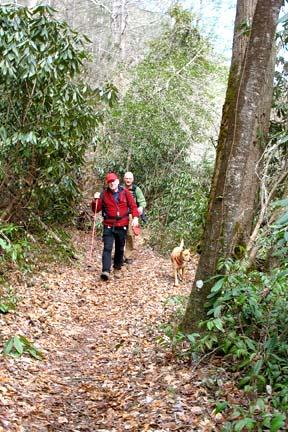What do you do when you see a visitor doing something inappropriate or illegal in a national park?
This is not a theoretical question, as I struggle with this a lot. I feel that it's different from breaking the rules on the street. National parks, from the largest, most iconic to the smallest historic site, are special places where the rules are there to protect the resources.
Do you ignore the problem, thinking that maybe rangers will deal with it?
Do you mention it to the visitor?
Do you try to find a ranger?
Does it depend on the problem? Everyone knows not to litter or to carve their initials on an historic cabin. But many visitors claim not to know that dogs are not allowed on trails in many national parks or that they shouldn't pick flowers.
Does your reaction depend on the park you're in? I'm particularly vocal in Great Smoky Mountains National Park and the Blue Ridge Parkway where I think I know the rules well. I'm quieter when I'm away from my home turf.
Does it depend on other circumstances?
How do you handle the problem?




Comments
Like Gaelyn, it doesn't matter what park I'm in, I'm still a ranger. When I see someone breaking the rules I always identify myself and explain the rules as politely as I can. Sometimes when I'm not in uniform I can get a little snippy when people are doing really stupid/dangerous/mean things. Like teenage boys throwing large rocks at an alligator or at Mesa Verde when some boys hopped over a fence and went running to the cliff edge. I wasn't terribly polite at those times, but (hopefully!) wasn't too mean. It is the job of rangers to protect the park from the people, the people from the park, and the people from the people, and I don't think it matters what park we're in.
As I spend most of my time in the backcountry, I've rarely run into this type of situation. However, I can recall two occasions - both in Yellowstone - where I spoke sternly, but as politely as I could to point out the offense to the rule breaker. And in both instances they complied with my request. I expect people to follow the rules, as I do, regardless of location or severity of the infraction.
What were the infractions, Dennis?
If I encounter a person with a dog I expalin to them it is against National Park rules then I go on explain why the rule is there. Dogs are non natural animals, to other natural animals they smell like wolves and the natural animals will stay away from the trails. If they ask where they can take their dogs in to forests I tell them BLM and the forest service allow dogs.
Making the decision as to whether or not to intercede when
one observes violations in National Parks is a personal decision that should be
made after fully assessing your situation.
Ask yourself some of these questions;
·
Is correcting the person worth placing yourself
in possible danger?
·
Do you have communications to call for help?
·
Do you have an escape route so you can get out
of the area in case the situation goes sour?
·
How many people are with the person committing
the offense?
·
What is the demeanor of the offender and any
companions – are they acting aggressive?
·
Do the offenders appear to be under the
influence of alcohol or drugs?
More than thirty two years as a National Park Ranger taught
me that people are one of the most unpredictable of creatures in our parks. You may be confident in yourself and
abilities, but you know nothing about the person you are about to confront. In the course of my career I found that
people are increasingly becoming more volatile when their actions are
questioned.
As soon as the person you have chosen to say something to
presents any signs of defiance or aggressiveness, I would highly recommend
leaving the area immediately.
Another alternative to taking action would be to make
detailed observations of the offenders such as:
§
Complete and accurate description of what you
observed
§
Physical descriptions of offenders
§
Clothing and outdoor gear that they have
§
Number and descriptions of companions
§
Specific location of where the offense occurred
§
Time of the offense
§
Descriptions including tag numbers of vehicle if
involved
§
Direction of travel of the offenders if they
left the area
As soon as possible report this information to a Park Ranger
or other authorized person.
Park Rangers are few and far between and they always
appreciate the assistance of additional eyes to protect our resources and your fellow
visitors. Most Park Rangers would also agree
that they never want a park visitor to endanger themselves in this process.
I'm more inclined to speak up if someone is annoying animals, littering, harming plants, etc. Less so if they are simply risking their own life and limb. Once saw a pilgrim edge closer and closer to a cow & calf moose trying to get a photo while wife & kid hollered for him to come back. Moose was getting really fed up! I sat on a stump to enjoy the show and maybe get some long-lens action photos. Only the arrival of a ranger prevented the gene pool from being improved!
The problem is many people in this country don't have any manners. They consider their dogs "people" and family and don't understand why you don't love Fido as they do.For God's sake most of them sleep with the dog!!!LOL
Hey, I sleep with my dog! She's better behaved than my grandkids. Than most kids, for that matter.
However, I don't need "mountain lion bait" when I'm on the trails. She stays home!